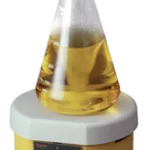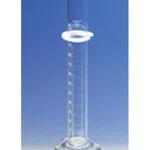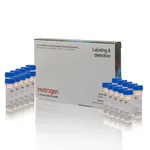
Thermo Fisher Scientific KLH Polyclonal Antibody, Agarose
✨AI 추천 연관 상품
AI가 분석한 이 상품과 연관된 추천 상품들을 확인해보세요
연관 상품을 찾고 있습니다...
Applications
Tested Dilution
Publications
Immunoprecipitation (IP)
15 - 25 µL gel slurry/0.1 - 1 mg of protein lysate
Product Specifications
Host/Isotype
Rabbit / IgG
Class
Polyclonal
Type
Antibody
Conjugate
Agarose Agarose Agarose
Form
Liquid
Storage conditions
4° C
Shipping conditions
Ambient (domestic); Wet ice (international)
Target Information
Keyhole limpet hemocyanin is an extremely large, heterogeneous glycosylated protein consisting of subunits with a molecular weight of 350,000 and 390,000 in aggregates with molecular weights of 4,500,000-13,000,000. Each domain of a KLH subunit contains two copper atoms that together bind a single oxygen molecule (O2). When oxygen is bound to hemocyanin, the molecule takes on a distinctive transparent, opalescent blue color. The KLH protein is potently immunogenic yet safe in humans and is therefore highly prized as a vaccine carrier protein. The large and highly glycosylated KLH protein cannot be reproduced synthetically. It is available only as a purified biological product from the Keyhole Limpet Megathura crenulata.Keyhole limpet hemocyanin (KLH) is used extensively as a carrier protein in the production of for research, biotechnology and therapeutic applications. Haptens are substances with a low molecular weight such as peptides, small proteins and drug molecules that are generally not immunogenic and require the aid of a carrier protein to stimulate a response from the immune system in the form of antibody production.[2] KLH is the most widely employed carrier proteins for this purpose. KLH is an effective carrier protein for several reasons. Its large size and numerous epitopes generate a substantial immune response, and abundance of lysine residues for coupling haptens, allows a high hapten:carrier protein ratio increasing the likelihood of generating hapten-specific . In addition, because KLH is derived from the limpet, a gastropod, it is phylogenetically distant from mammalian proteins, thus reducing false positives in immunologically based research techniques in mammalian model organisms. KLH may also be a challenging molecule to work with because of its propensity to aggregate and precipitate. Aggregates remain immunogenic, but limit the ability to conjugate haptens and are difficult to manipulate in the laboratory.
For Research Use Only. Not for use in diagnostic procedures. Not for resale without express authorization.
🏷️Thermo Fisher Scientific 상품 둘러보기
동일 브랜드의 다른 상품들을 확인해보세요

Thermo Fisher Scientific
Thermo Fisher Scientific StirBuddy Personal Stirrer
379,500원

Thermo Fisher Scientific
Thermo Fisher Scientific PYREX Single Metric Scale, Graduated Cylinder, TC, with Funnel Top
63,200원

Thermo Fisher Scientific
Thermo Fisher Scientific KLH Polyclonal Antibody, Agarose
196,700원

Thermo Fisher Scientific
Thermo Fisher Scientific Super-Nuova 4-Position Digital Stirrer, 220-240V
4,000,000원

Thermo Fisher Scientific
Thermo Fisher Scientific SBFI, AM, cell permeant - Special Packaging
1,178,900원
배송/결제/교환/반품 안내
배송 정보
| 기본 배송비 |
| 교환/반품 배송비 |
|
|---|---|---|---|
| 착불 배송비 |
| ||
| 교환/반품 배송비 |
| ||
결제 및 환불 안내
| 결제수단 |
|
|---|---|
| 취소 |
|
| 반품 |
|
| 환급 |
|
교환 및 반품 접수
| 교환 및 반품 접수 기한 |
|
|---|---|
| 교환 및 반품 접수가 가능한 경우 |
|
| 교환 및 반품 접수가 불가능한 경우 |
|
교환 및 반품 신청
| 교환 절차 |
|
|---|---|
| 반품 절차 |
|
